Article and all photos by Joe Mock, BaseballParks.com
All rights reserved
 |
The operators of sports facilities love to talk about how theirs is the newest, the biggest, the first of its kind, the most expensive to build and most importantly, the best. Well, here’s your winner on all counts.
| Ballpark Stats |
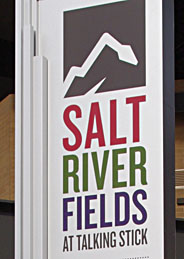 |
| Award: Baseballparks.com’s Ballpark Of The Year for 2011 (press release) |
| Team: Spring Training home of the Rockies and Diamondbacks |
| First game: Feb. 26, 2011, an 8-7 win by the Rockies over the D-backs |
| Capacity: 11,000, of which 7,000 are fixed seats |
| Architect: HKS |
| Construction: Mortenson |
| Price: unofficially over $100 million |
| Home dugout: Rockies 1B side, D-backs 3B side |
| Field points: East by northeast |
| Playing surface: Tifway 419 Bermudagrass |
| Betcha didn’t know: 10 miles worth of underground utilities lie beneath the complex’s surface |
Salt River Fields at Talking Stick is the newest spring training complex. Its sprawling 150 acres provide a rolling landscape for the first such complex to be built on Indian land. Hands down, this spring-training project is larger in scope than any other, whether in Florida or Arizona … although the exact dollar expenditure has never been made public. And in my humble opinion, Salt River Fields sets the standard when it comes to spring training.
But as impressive as its work-out facilities, practice fields, ease of access and the centralized stadium are, the most noteworthy aspect is this: it says baseball through and through.
Byron Chambers, the lead designer on this project for HKS Architects, put it this way: “My favorite aspect of this complex is its intensive baseball immersion experience.” Not only is that a colorful and eloquent choice of words, it’s also true. Everything about the aesthetics, the arrangement, the landscaping and the architecture of the structures draws you into full participation with the sport of baseball. No wonder it won our Ballpark Of The Year award for 2011.
When doing a review of a spring training ballpark, it’s difficult to ignore the practice facilities surrounding it and focus only on the stadium. Consequently, I’m not going to attempt to do that in this article. Everything is so organically designed here that to say that it works well is an understatement. Further, HKS didn’t simply create mirror images of the practice areas for each team. No, they listened to what was important to the two tenants (the Rockies and Diamondbacks) and customized each set of fields and central buildings to meet the needs of that team. And both sets of facilities are beautiful.
How did these two teams come to cohabitate at this spot in the desert? Well, the White Sox actually had a lot to do with it.
| Be-FORE it was a baseball complex |
 |
| It’s now been awhile since golfers were yelling FORE at the Pavilion Lakes Golf Club, which included this bunker. The Indian Community owned the land, and they transformed it into a gorgeous spring-training complex. |
Since 1998, three MLB teams had conducted spring training in Tucson, about a two-hour drive south from Phoenix. The White Sox and D-backs trained across the highway from each other in South Tucson, and they shared the Tucson Electric Park (more recently called Kino Stadium) for their exhibition games. A couple miles to the north, the Rockies utilized the complex that surrounded aging Hi Corbett Field.
The White Sox were the first of the three to get antsy to head out of town. They were lured away to the suburbs west of Phoenix to join the Dodgers in a new complex that opened in 2009. That complex, called Camelback Ranch, is in Glendale (technically, it’s on land owned by Phoenix, but it is generally referred to as Glendale), not far from the massive University of Phoenix football stadium.
That left the Rockies and D-backs as the only teams left in Tucson. Interestingly, they had an escape clause in their leases that said they could leave town if they were the only two MLB teams in Tucson. When they decided to invoke that clause, the Salt River Pima-Maricopa Indian Community (SRPMIC) swooped in with an offer to build the two teams a state-of-the-art complex on the Community’s land in the East Valley of Phoenix. The Rockies and D-backs took them up on it, and they moved into their new facilities in February of 2011.
Truly, players didn’t like the long bus rides for exhibition games in Tucson, and fans weren’t crazy about following their favorite team down I-10, either. Having all 15 of Arizona’s teams training and playing exhibitions in the Phoenix metro area made players and fans alike very happy. Undoubtedly, though, the folks who live around Tucson weren’t too pleased, and on some level, I’m sure the Diamondbacks didn’t want to be viewed as turning their backs on the south Arizona market, since they’d like for baseball fans there to make the drive to Chase Field and to purchase D-backs merchandise.
The Setting
It is indeed noteworthy that this is the first spring-training complex built on Indian land. When I first read that this was going to happen, I envisioned having to drive a long way from civilization to get to the new complex. Nothing could’ve been further from the truth.
In fact, if you think of Loop 101 as forming the eastern, northern and western “beltway” of the Phoenix Metro Area, then Salt River Fields are actually inside the beltway! That’s because the land of the two tribes that comprise the Salt River Pima-Maricopa Indian Community extends on its western boundary to the city limits of Scottsdale. And a small slice of this land is on the western side of Loop 101. That actually makes the new complex closer to Scottsdale’s downtown area (with all of the fancy restaurants and boutiques) than all of the famous golf resorts (over 200 courses) you’ve heard about on Scottsdale’s northern side.
The Community had already taken advantage of having territory so close to Loop 101. In a brilliant move, they constructed the massive Casino Arizona at Talking Stick, the 15-story Talking Stick Resort & Spa and a 36-hole country club of the same name just a few hundred yards east of Loop 101. The final portions of this complex opened in 2010. Not only did the location give the facility a great deal of visibility by the traffic on 101, it also gave tourists the ability to sample first-class Indian gaming without having to travel way out into the desert.
One assumes this hotel/casino/country club provided the Community with a decent cash flow — one that made it easier for them to pour an amount in nine figures into the spring training complex.
And Salt River Fields is located almost directly across Loop 101 from the hotel complex. Good thinking.
 |
For half a century, the 250 acres for the spring-training complex were the Pavilion Lakes Golf Club. The public course originally opened in 1948, and it offered golfers wonderful views of the McDowell and Camelback Mountains. In recent years, though, it had deteriorated, and when the Rockies and D-backs became eager to move out of Tucson, the course represented the ideal site for spring training. In early 2009, right after I heard that this was the likely site for a new complex, I searched it out and gave it a thorough look-over (the photo above, showing the Talking Stick Spa & Resort under construction, was taken on that excursion). I couldn’t believe its great, convenient location and its superb views of the mountains. I figured that Salt River Fields was going to be a winner, and when I saw the finished product for the first time, I saw that my assumption had been proven correct. Overwhelmingly so.
The photo on the left below shows the view of the McDowell Mountains from one of the practice fields on the Diamondbacks’ side of the complex. Yes, the location provides some great scenery.
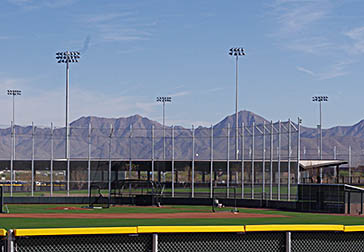 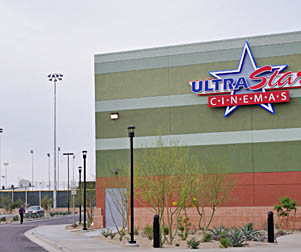 |
To be precise, the site of the complex on the western edge of Loop 101 is along North Pima Road, north of Indian Bend Road and south of Via De Ventura. Both of these east-west roads have intersections with Loop 101. One of the great aspects of the complex is that you can access it from the north on Via De Ventura, and from three points along Pima.
On the southern edge of the complex is the Pavilions Shopping Center, which had been the first commercial development on the Indian Community’s land. Its 1.1 million square feet of retail space straddles both sides of Indian Bend Road.
Like the golf course, the center hadn’t been doing well in recent years. A large movie theater had closed, and there were a lot of vacant storefronts when I first visited in 2009. I’m happy to say that the center looked a lot healthier after Salt River Fields opened, as the theater had been re-opened (the Ultra Star Cinemas, on the top right, showing the Rockies’ practice fields just a few hundred feet away), and there appeared to be a lot more commerce happening. Who says a baseball facility can’t help the economy in its immediate vicinity?
A lot of land just outside of the complex has been set aside for future commercial development along Pima Road and Via De Ventura. One could see that in a more-robust economy it could indeed occur, although both the Goodyear and Glendale complexes that opened in 2009 have yet to see much of any of the commercial development forecasted for their peripheries.
Finally, when I asked HKS’ Byron Chambers whether it helped or hurt the process that they had to design the complex on an abandoned golf course, he said, “It was a non-factor. We looked at it like we were working with a blank site. After several meetings with both teams and the (Indian) Community, we designed it to meet everyone’s needs.
“Because we only wanted to use native vegetation in the landscaping,” he continued, “one advantage of the (golf course) location was that we were able to keep about 80 native trees on the site. It would’ve taken 15 years for new plants to grow to the size of those trees.”
Mo Stein, Principal In Charge at HKS, also pointed out that when they carefully examined the golf course before design work began, they took note of the prevailing winds. Consequently, the design for the ballpark “takes advantage of the natural breezes we knew would be available on site,” he explained.
The Exterior
Stein took me on a tour of the complex and its ballpark. He was most kind and was also very thorough in showing me around for three hours. And we still didn’t see it all.
That should give you some idea of the extent of the facilities here.
During the tour, we were fortunate to run into Roland Hemond, longtime baseball executive who is being presented with the Buck O’Neil Lifetime Achievement Award by the Hall of Fame later this year. When asked what he thought of Salt River Fields, he replied, “I can’t explain how great this (complex) is. I tell people that you’ve got to come and see it for yourself.”
Indeed. There is so much to experience here, and it hits you the moment you arrive. “The minute you drive in here, you’re in baseball,” Stein observed. “And you can spend the day here watching baseball and not spend any money” if you don’t attend an exhibition game.
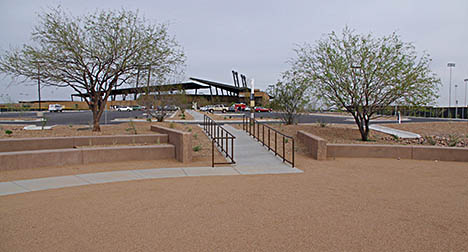 |
One of the first aspects of the complex that you’ll notice when you drive in from Pima Road is the Veterans Circle (above). This is one stop on the Stewardship Trail that meanders along the western edge of the site. “Native Americans from this Community and others served with great distinction in the U.S. military,” Stein explained. “Since we are on Indian land, we felt it was important to incorporate a ceremonial dance circle to honor their veterans.”
Near here is a “reflection trail” in honor of Keli McGregor, the Rockies’ vibrant president who passed away unexpectedly on April 20, 2010 due to a rare viral infection around his heart. Needless to say, the death of the 48 year old sent shock waves around the baseball world. He was very instrumental in the team moving their spring operations here, and his input helped shape the way the complex turned out. McGregor is also honored in numerous ways within the Rockies’ clubhouse building.
 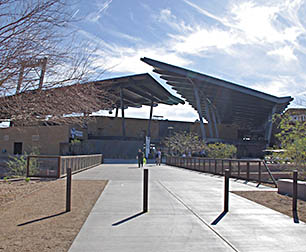 |
Near the Stewardship Trail is a three-and-a-half-acre pond that is fed from wells. This water is used to irrigate the fields — and two-million square feet of sod requires a lot of water! A small amount of the water is pumped to a fountain near the ballpark’s main entrance, and water from the fountain then flows lazily back to the pond (above left). This small amount of flowing water is traversed by a metal bridge that you must cross to enter the ballpark (above right). Don’t rush as you cross this bridge, because the metal used in its construction creates a lovely sound as you walk across it. Take your time and enjoy this nice touch.
Stein explained that the complex is comprised of four major areas: The “Community” near its center; the Rockies side on the south; the D-backs side on the north; and the “baseball” side largely on the east. If you’re a fan of either team, you’ll undoubtedly want to park on your team’s “side” and enter the practice areas from there. While the pathways and fields themselves are both immaculate and beautifully landscaped, what will take your breath away are the two clubhouse buildings for the teams. But the term “clubhouse” doesn’t come close to doing these two structures justice.
 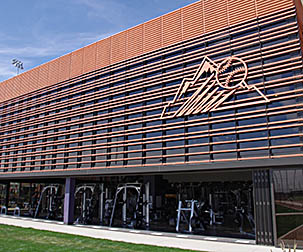 |
If you’re fortunate enough to get to see the interior of these two structures, be prepared to have even more of your breath taken away.
Let’s look at the Rockies’ building as an example. It features a two-story lobby with walls made of planks from fir trees (below left). These aren’t just any firs, though. They are from Colorado — plus they were reclaimed from beetle-infested trees, which is one of the many ways the construction was environmentally friendly. Not far from the stunning Major League players clubhouse (below center) is the Keli S. McGregor Fitness Center, which is spacious and state-of-the art.
The Rockies’ building also features a large theater (below right) where young players learn not only the specifics of playing the game, they are also taught the Rockies’ way of handling themselves. It is very impressive.
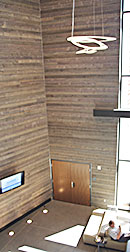 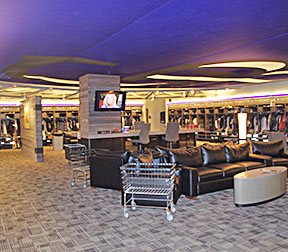 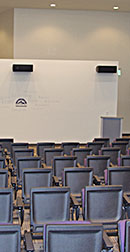 |
The Diamondbacks’ structure is equally impressive, but by no means is it a mirror image of the one for the Rockies. Far from it.
While both clubhouse/training buildings are integrated into the outfield of the central ballpark (meaning from the upper level of each of them you can see into the park), each was customized for that team. HKS’ Chambers explained that the planning meetings with the Indian Community and the D-backs and Rockies before any design work was done were critical. “We wanted to make all of them happy, because the complex was to have one owner (the Community) and two tenants (the teams).”
HKS learned that the Rockies and Diamondbacks have two different philosophies. “The Rockies organizational philosophy is that they want the Major Leaguers and the Minor Leaguers to co-mingle, so we designed their area to accommodate that,” Chambers said. Indeed, the training facilities and locker rooms for the veterans and the youngsters are together on the lower level of their building. “The D-backs, on the other hand, feel that a young player needs to earn the right to be on the Major League side of the facilities, so we designed it so that they are kept separate.”
The ballpark at the center of the complex is no less impressive. The entryway near home plate is both gorgeous and well-thought-out, especially since the park’s iconic signature (separate roofs over each side of the stands that overlap each other slightly) looms above you. On the right side of this entryway are the ticket windows. On the left side is a series of panels with greetings (in the native languages of the Maricopa and the Pima tribes) carved into the concrete.
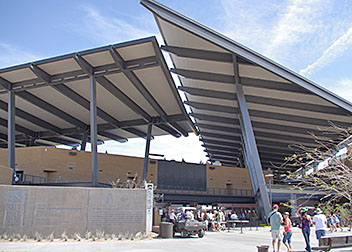  |
When you enter through the main entryway (above left), you walk almost directly underneath the spot where the two roofs overlap. The new home of the Gwinnett Braves of the International League is the only other recent ballpark with such a roof structure, and perhaps not coincidentally, it was also designed by HKS — although I greatly prefer the aesthetics of the two roofs here over Gwinnett. When I asked HKS’ Stein about the dual roofs, he pointed out that “two is a very symbolic number for this project. There are two teams playing here, two Indian Communities and two rivers associated with those Communities, so we thought two roofs made sense.” He also pointed out that the two roofs allowed them to harness the shade.
Ah, the shade. Much has been made about how important shade is at this particular park. At HKS’ most recent spring-training project, Camelback Ranch in Glendale, a number of fans have commented that there isn’t nearly enough shade in the ballpark’s expansive stands.
“The pitch of the seating bowl, the slope of the roofs, the park’s length, its width and its orientation were all specifically done for the shade,” Stein revealed. Chambers echoed this. “Shade is massively important in this project. It was right up there with the fan experience. When we were designing the complex, we had two main goals: taking advantage of the great vistas and providing shade (in the stands). If a line from home plate to third base is pointing mostly north, then having big roof planes on the south and west would provide the most shade.” Indeed, intensive shade studies were conducted to calculate exactly how to create the most shade during the month of March, during the period of the afternoon when exhibition games are usually played. The results of those studies drove the orientation of the park and many other decisions about the park’s structure.
And all of HKS’ analysis was a success. Every seat above the cross-aisle in the main seating bowl is in the shade by the first pitch of an afternoon exhibition game in March. By the third or fourth inning, shade has descended on about 85% of all of the seats.
But there are areas where plenty of light enters the stadium, and it’s quite intentional. Sometimes when fans are attending an exhibition game inside the ballpark, there are minor league contests or “B games” taking place in the practice fields right next to the park. HKS wanted fans within the confines of the big stadium to be able to look through fences (above right) and watch those other games.
In addition to the main entryway near home plate, there are three other ways to enter the ballpark. There are entry gates near the Rockies’ and D-backs’ practice fields, plus there is a more elaborate gate in center field. It has ticket windows and is near one of the three souvenir shops. There is also a large parking lot just outside of this gate. This lot is on the extreme eastern edge of the project, and is easily accessed by the road that rings the complex.
Now let’s take a look inside the ballpark.